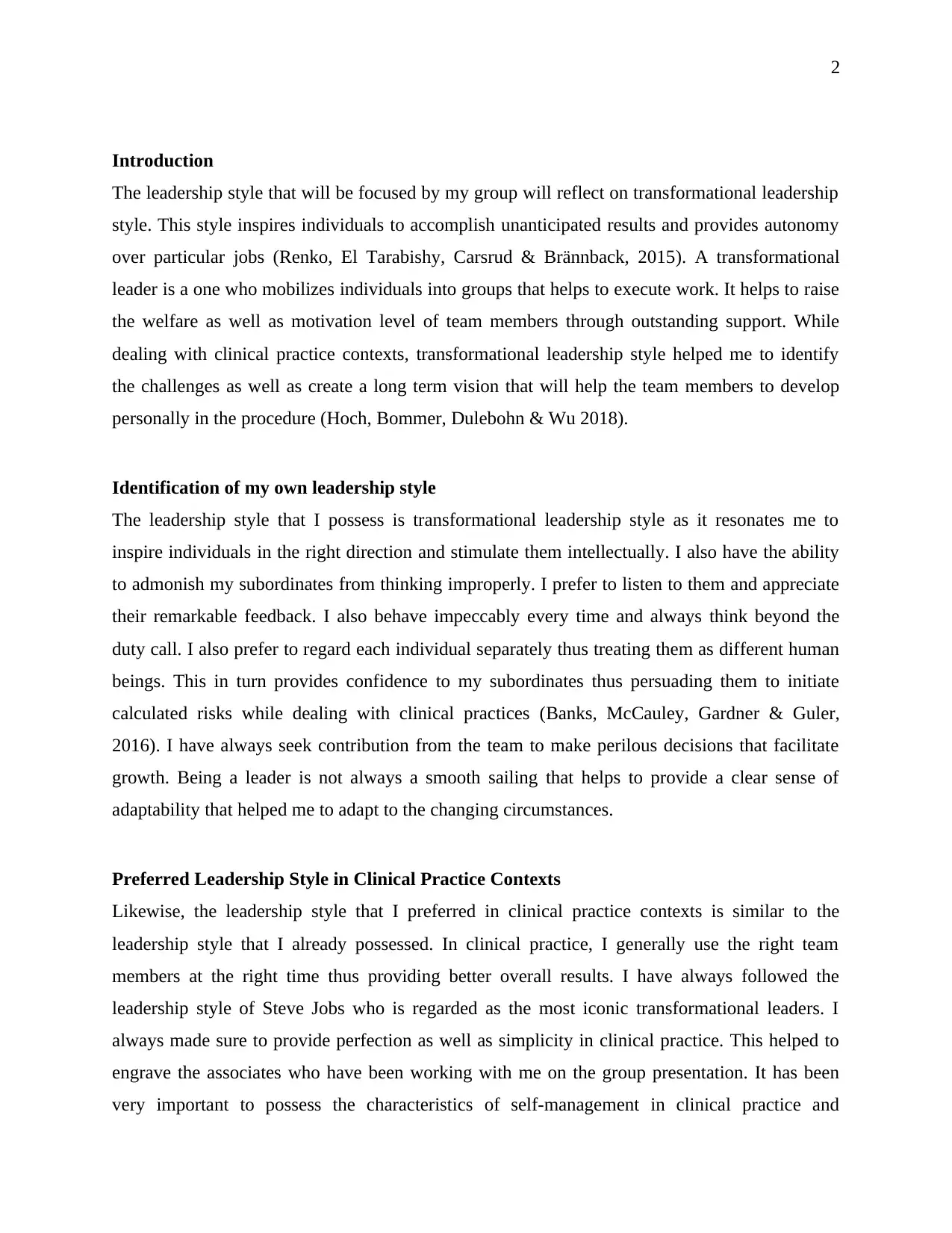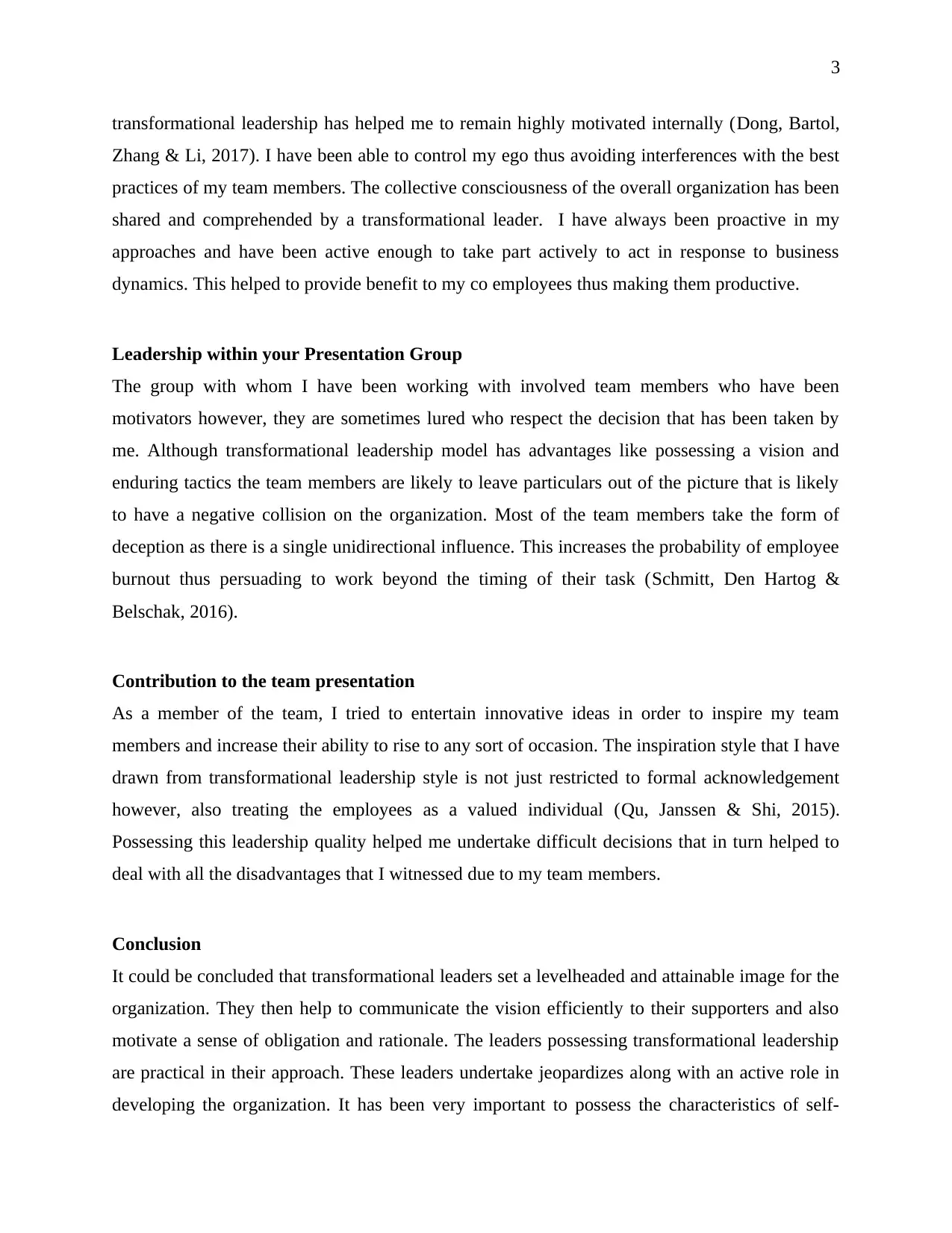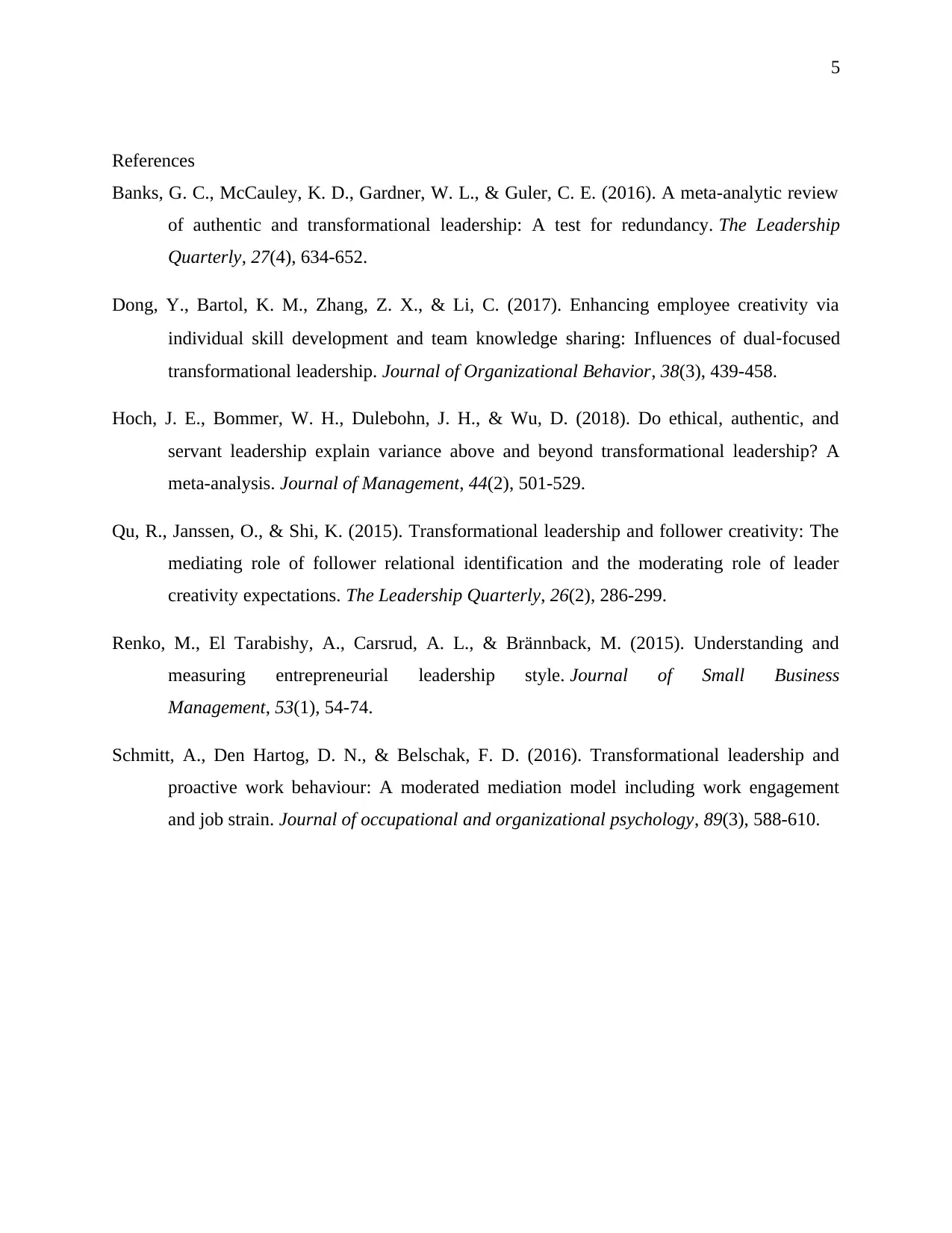Personal Reflection: Leadership Style and Clinical Practice Context
VerifiedAdded on 2023/06/03
|5
|1126
|176
Report
AI Summary
This report provides a critical reflection on transformational leadership within a clinical practice context. The author identifies with the transformational leadership style, emphasizing its ability to inspire and intellectually stimulate team members. The reflection covers the author's leadership style, preferred leadership approaches in clinical settings, leadership dynamics within a presentation group, and individual contributions to team presentations. The report concludes by highlighting the importance of adaptability, self-management, and proactive approaches in effective leadership, drawing parallels with iconic transformational leaders like Steve Jobs. The author also reflects on the importance of innovative ideas to inspire team members and increase their ability to rise to any sort of occasion.

1
Transformational Leadership Style
Transformational Leadership Style
Paraphrase This Document
Need a fresh take? Get an instant paraphrase of this document with our AI Paraphraser

2
Introduction
The leadership style that will be focused by my group will reflect on transformational leadership
style. This style inspires individuals to accomplish unanticipated results and provides autonomy
over particular jobs (Renko, El Tarabishy, Carsrud & Brännback, 2015). A transformational
leader is a one who mobilizes individuals into groups that helps to execute work. It helps to raise
the welfare as well as motivation level of team members through outstanding support. While
dealing with clinical practice contexts, transformational leadership style helped me to identify
the challenges as well as create a long term vision that will help the team members to develop
personally in the procedure (Hoch, Bommer, Dulebohn & Wu 2018).
Identification of my own leadership style
The leadership style that I possess is transformational leadership style as it resonates me to
inspire individuals in the right direction and stimulate them intellectually. I also have the ability
to admonish my subordinates from thinking improperly. I prefer to listen to them and appreciate
their remarkable feedback. I also behave impeccably every time and always think beyond the
duty call. I also prefer to regard each individual separately thus treating them as different human
beings. This in turn provides confidence to my subordinates thus persuading them to initiate
calculated risks while dealing with clinical practices (Banks, McCauley, Gardner & Guler,
2016). I have always seek contribution from the team to make perilous decisions that facilitate
growth. Being a leader is not always a smooth sailing that helps to provide a clear sense of
adaptability that helped me to adapt to the changing circumstances.
Preferred Leadership Style in Clinical Practice Contexts
Likewise, the leadership style that I preferred in clinical practice contexts is similar to the
leadership style that I already possessed. In clinical practice, I generally use the right team
members at the right time thus providing better overall results. I have always followed the
leadership style of Steve Jobs who is regarded as the most iconic transformational leaders. I
always made sure to provide perfection as well as simplicity in clinical practice. This helped to
engrave the associates who have been working with me on the group presentation. It has been
very important to possess the characteristics of self-management in clinical practice and
Introduction
The leadership style that will be focused by my group will reflect on transformational leadership
style. This style inspires individuals to accomplish unanticipated results and provides autonomy
over particular jobs (Renko, El Tarabishy, Carsrud & Brännback, 2015). A transformational
leader is a one who mobilizes individuals into groups that helps to execute work. It helps to raise
the welfare as well as motivation level of team members through outstanding support. While
dealing with clinical practice contexts, transformational leadership style helped me to identify
the challenges as well as create a long term vision that will help the team members to develop
personally in the procedure (Hoch, Bommer, Dulebohn & Wu 2018).
Identification of my own leadership style
The leadership style that I possess is transformational leadership style as it resonates me to
inspire individuals in the right direction and stimulate them intellectually. I also have the ability
to admonish my subordinates from thinking improperly. I prefer to listen to them and appreciate
their remarkable feedback. I also behave impeccably every time and always think beyond the
duty call. I also prefer to regard each individual separately thus treating them as different human
beings. This in turn provides confidence to my subordinates thus persuading them to initiate
calculated risks while dealing with clinical practices (Banks, McCauley, Gardner & Guler,
2016). I have always seek contribution from the team to make perilous decisions that facilitate
growth. Being a leader is not always a smooth sailing that helps to provide a clear sense of
adaptability that helped me to adapt to the changing circumstances.
Preferred Leadership Style in Clinical Practice Contexts
Likewise, the leadership style that I preferred in clinical practice contexts is similar to the
leadership style that I already possessed. In clinical practice, I generally use the right team
members at the right time thus providing better overall results. I have always followed the
leadership style of Steve Jobs who is regarded as the most iconic transformational leaders. I
always made sure to provide perfection as well as simplicity in clinical practice. This helped to
engrave the associates who have been working with me on the group presentation. It has been
very important to possess the characteristics of self-management in clinical practice and

3
transformational leadership has helped me to remain highly motivated internally (Dong, Bartol,
Zhang & Li, 2017). I have been able to control my ego thus avoiding interferences with the best
practices of my team members. The collective consciousness of the overall organization has been
shared and comprehended by a transformational leader. I have always been proactive in my
approaches and have been active enough to take part actively to act in response to business
dynamics. This helped to provide benefit to my co employees thus making them productive.
Leadership within your Presentation Group
The group with whom I have been working with involved team members who have been
motivators however, they are sometimes lured who respect the decision that has been taken by
me. Although transformational leadership model has advantages like possessing a vision and
enduring tactics the team members are likely to leave particulars out of the picture that is likely
to have a negative collision on the organization. Most of the team members take the form of
deception as there is a single unidirectional influence. This increases the probability of employee
burnout thus persuading to work beyond the timing of their task (Schmitt, Den Hartog &
Belschak, 2016).
Contribution to the team presentation
As a member of the team, I tried to entertain innovative ideas in order to inspire my team
members and increase their ability to rise to any sort of occasion. The inspiration style that I have
drawn from transformational leadership style is not just restricted to formal acknowledgement
however, also treating the employees as a valued individual (Qu, Janssen & Shi, 2015).
Possessing this leadership quality helped me undertake difficult decisions that in turn helped to
deal with all the disadvantages that I witnessed due to my team members.
Conclusion
It could be concluded that transformational leaders set a levelheaded and attainable image for the
organization. They then help to communicate the vision efficiently to their supporters and also
motivate a sense of obligation and rationale. The leaders possessing transformational leadership
are practical in their approach. These leaders undertake jeopardizes along with an active role in
developing the organization. It has been very important to possess the characteristics of self-
transformational leadership has helped me to remain highly motivated internally (Dong, Bartol,
Zhang & Li, 2017). I have been able to control my ego thus avoiding interferences with the best
practices of my team members. The collective consciousness of the overall organization has been
shared and comprehended by a transformational leader. I have always been proactive in my
approaches and have been active enough to take part actively to act in response to business
dynamics. This helped to provide benefit to my co employees thus making them productive.
Leadership within your Presentation Group
The group with whom I have been working with involved team members who have been
motivators however, they are sometimes lured who respect the decision that has been taken by
me. Although transformational leadership model has advantages like possessing a vision and
enduring tactics the team members are likely to leave particulars out of the picture that is likely
to have a negative collision on the organization. Most of the team members take the form of
deception as there is a single unidirectional influence. This increases the probability of employee
burnout thus persuading to work beyond the timing of their task (Schmitt, Den Hartog &
Belschak, 2016).
Contribution to the team presentation
As a member of the team, I tried to entertain innovative ideas in order to inspire my team
members and increase their ability to rise to any sort of occasion. The inspiration style that I have
drawn from transformational leadership style is not just restricted to formal acknowledgement
however, also treating the employees as a valued individual (Qu, Janssen & Shi, 2015).
Possessing this leadership quality helped me undertake difficult decisions that in turn helped to
deal with all the disadvantages that I witnessed due to my team members.
Conclusion
It could be concluded that transformational leaders set a levelheaded and attainable image for the
organization. They then help to communicate the vision efficiently to their supporters and also
motivate a sense of obligation and rationale. The leaders possessing transformational leadership
are practical in their approach. These leaders undertake jeopardizes along with an active role in
developing the organization. It has been very important to possess the characteristics of self-
⊘ This is a preview!⊘
Do you want full access?
Subscribe today to unlock all pages.

Trusted by 1+ million students worldwide

4
management in clinical practice and transformational leadership has helped me to remain highly
motivated internally.
management in clinical practice and transformational leadership has helped me to remain highly
motivated internally.
Paraphrase This Document
Need a fresh take? Get an instant paraphrase of this document with our AI Paraphraser

5
References
Banks, G. C., McCauley, K. D., Gardner, W. L., & Guler, C. E. (2016). A meta-analytic review
of authentic and transformational leadership: A test for redundancy. The Leadership
Quarterly, 27(4), 634-652.
Dong, Y., Bartol, K. M., Zhang, Z. X., & Li, C. (2017). Enhancing employee creativity via
individual skill development and team knowledge sharing: Influences of dual‐focused
transformational leadership. Journal of Organizational Behavior, 38(3), 439-458.
Hoch, J. E., Bommer, W. H., Dulebohn, J. H., & Wu, D. (2018). Do ethical, authentic, and
servant leadership explain variance above and beyond transformational leadership? A
meta-analysis. Journal of Management, 44(2), 501-529.
Qu, R., Janssen, O., & Shi, K. (2015). Transformational leadership and follower creativity: The
mediating role of follower relational identification and the moderating role of leader
creativity expectations. The Leadership Quarterly, 26(2), 286-299.
Renko, M., El Tarabishy, A., Carsrud, A. L., & Brännback, M. (2015). Understanding and
measuring entrepreneurial leadership style. Journal of Small Business
Management, 53(1), 54-74.
Schmitt, A., Den Hartog, D. N., & Belschak, F. D. (2016). Transformational leadership and
proactive work behaviour: A moderated mediation model including work engagement
and job strain. Journal of occupational and organizational psychology, 89(3), 588-610.
References
Banks, G. C., McCauley, K. D., Gardner, W. L., & Guler, C. E. (2016). A meta-analytic review
of authentic and transformational leadership: A test for redundancy. The Leadership
Quarterly, 27(4), 634-652.
Dong, Y., Bartol, K. M., Zhang, Z. X., & Li, C. (2017). Enhancing employee creativity via
individual skill development and team knowledge sharing: Influences of dual‐focused
transformational leadership. Journal of Organizational Behavior, 38(3), 439-458.
Hoch, J. E., Bommer, W. H., Dulebohn, J. H., & Wu, D. (2018). Do ethical, authentic, and
servant leadership explain variance above and beyond transformational leadership? A
meta-analysis. Journal of Management, 44(2), 501-529.
Qu, R., Janssen, O., & Shi, K. (2015). Transformational leadership and follower creativity: The
mediating role of follower relational identification and the moderating role of leader
creativity expectations. The Leadership Quarterly, 26(2), 286-299.
Renko, M., El Tarabishy, A., Carsrud, A. L., & Brännback, M. (2015). Understanding and
measuring entrepreneurial leadership style. Journal of Small Business
Management, 53(1), 54-74.
Schmitt, A., Den Hartog, D. N., & Belschak, F. D. (2016). Transformational leadership and
proactive work behaviour: A moderated mediation model including work engagement
and job strain. Journal of occupational and organizational psychology, 89(3), 588-610.
1 out of 5
Related Documents
Your All-in-One AI-Powered Toolkit for Academic Success.
+13062052269
info@desklib.com
Available 24*7 on WhatsApp / Email
![[object Object]](/_next/static/media/star-bottom.7253800d.svg)
Unlock your academic potential
Copyright © 2020–2025 A2Z Services. All Rights Reserved. Developed and managed by ZUCOL.





